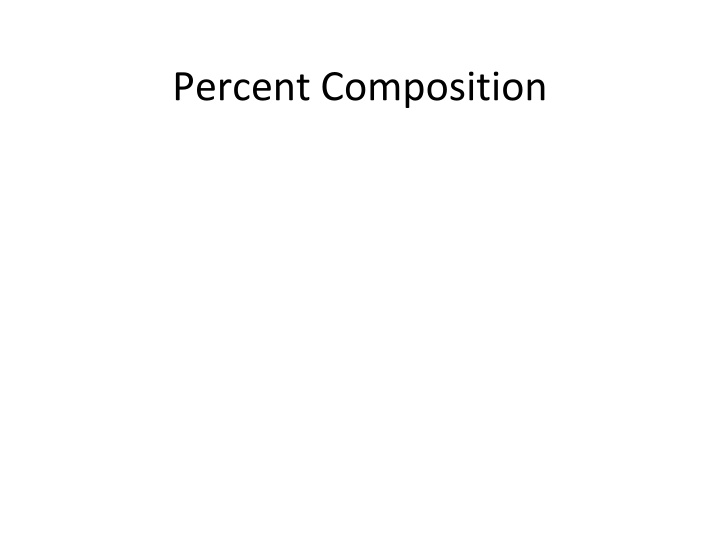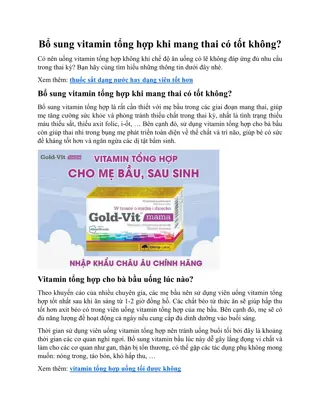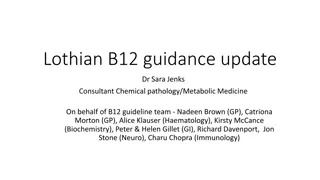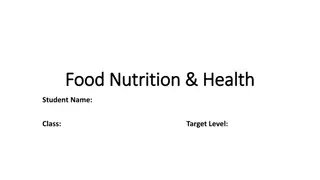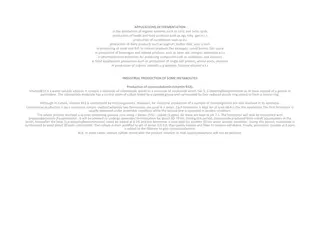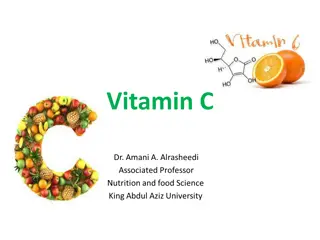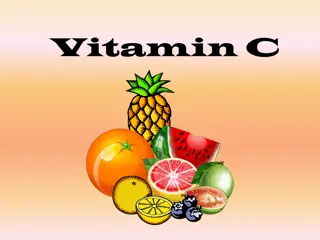The Story of Vitamin B12 and Coenzymes
Physicians discovered the treatment of anemia using liver, leading to the identification of Vitamin B12. Dorothy Crowfoot Hodgkin determined the complete structure of B12, awarded the Nobel Prize for her work. Vitamin B12 is water-soluble, red in color, and contains a corrin ring system with a cobalt atom. Various forms of Vitamin B12 exist with different functional coenzymes in the body.
Download Presentation

Please find below an Image/Link to download the presentation.
The content on the website is provided AS IS for your information and personal use only. It may not be sold, licensed, or shared on other websites without obtaining consent from the author.If you encounter any issues during the download, it is possible that the publisher has removed the file from their server.
You are allowed to download the files provided on this website for personal or commercial use, subject to the condition that they are used lawfully. All files are the property of their respective owners.
The content on the website is provided AS IS for your information and personal use only. It may not be sold, licensed, or shared on other websites without obtaining consent from the author.
E N D
Presentation Transcript
Calculating Percent Composition Sometimes it is important to know the relative amounts of the components of compounds and mixtures. One situation where this becomes important is after synthesizing a new compound. Its formula must be determined. The first step find the relative amounts of each element of the compound the percent composition by mass of the compound.
A sample of a substance containing only magnesium and chlorine was tested in the laboratory and was found to be composed of 74.5% chlorine by mass. If the total mass of the sample was 190.2 grams, what was the mass of the magnesium?
What is the percent by mass of oxygen in magnesium oxide, MgO? Find molar mass (mass of whole); divide the mass of the element you are looking for by the molar mass.
The percent by mass of carbon in HC2H3O2is equal to ? The % by mass of oxygen in ethanoic acid is???
Hydrates Water is a highly polar molecule it has some ionic character, and is often found in ionic compounds Examples include: Gypsum (drywall) Epsom salts CaSO4 2H2O MgSO4 7H2O When heated, the water evaporates from the crystal, leaving the anhydrous form of the crystal:
Hydrates Decompose When Heated CaSO4 2H2O (s) + heat ? CaSO4(s) + 2H2O (g) Calcium sulfate dihydrate anhydrous calcium sulfate MgSO4 7H2O (s) + heat ? MgSO4(s) + 7H2O (g) magnesium sulfate heptahydrate anhydrous magnesium sulfate
A hydrate is a compound that includes water molecules within its crystal structure. During an experiment to determine the percent by mass of water in a hydrated crystal, a student found the mass of the hydrated crystal to be 4.10 grams. After heating to constant mass, the mass was 3.70 grams. What is the percent by mass of water in this crystal?
HW: Calculate % by mass for each element AgCN name__________________ FeSO4 name _________________ CCl4 name __________________ CaBr2name __________________
Mg(OH)2name_________________ NO2name ___________________ Al2O3Name __________________ SF6__________________________
Lab 10:Water Of Hydration Of A Crystal You are to determine experimentally the number of water molecules (n) in a crystal of CuSO4 nH2O. To find n, you will heat a known mass of the hydrate to drive off the water. The crystals will become powdery and lose their deep blue color. You can then determine the mass of water present per mass of crystal.
? ? CuSO4 nH2O + heat ? CuSO4+ nH2O A must at all times!!!!
Materials crucible crucible tongs pipestem triangle ringstand bunsen burner striker balance
Hazards Associated With Copper Sulfate Eye: Exposure to particulates or solution may cause conjunctivitis, ulceration, and corneal abnormalities. Causes eye irritation and possible burns. Skin: May cause skin sensitization, an allergic reaction, which becomes evident upon re-exposure to this material. Causes skin irritation and possible burns. May cause itching eczema.
More Hazards Ingestion: Harmful if swallowed. May cause severe gastrointestinal tract irritation with nausea, vomiting and possible burns. Ingestion of large amounts of copper salts may cause bloody stools and vomit, low blood pressure, jaundice and coma. Ingestion of copper compounds may produce systemic toxic effects to the kidney and liver and central nervous excitation followed by depression. Inhalation: May cause ulceration and perforation of the nasal septum if inhaled in excessive quantities. Causes respiratory tract irritation with possible burns.
If you have a problem: Eyes: Immediately flush eyes with plenty of water for at least 15 minutes, occasionally lifting the upper and lower eyelids. Get medical aid. Skin: Get medical aid. Flush skin with plenty of soap and water for at least 15 minutes while removing contaminated clothing and shoes. Wash clothing before reuse.
Ingestion: Do NOT induce vomiting. If victim is conscious and alert, give 2-4 cupfulls of milk or water. Never give anything by mouth to an unconscious person. Get medical aid immediately. Inhalation: Remove from exposure to fresh air immediately. If breathing is difficult, give oxygen. Get medical aid. Do NOT use mouth-to-mouth resuscitation. If breathing has ceased apply artificial respiration using oxygen and a suitable mechanical device such as a bag and a mask.
Using the Bunsen Burner The gas (propane, C3H8) is controlled by several valves. Perpendicular to nozzle: closed Parallel to nozzle: fully open!
Bunsen Burner Valve There is a screw valve on the burner. This should always be closed when opening the sink valve. To turn close this valve, turn it clockwise.
Air Intake Valve The shaft of the burner has an air intake valve. This valve needs to be fully open for complete combustion to occur.
Hazards of Incomplete Combustion When enough oxygen is present in the gas mix C3H8+ O2? CO2 + H2O When not enough oxygen is available, carbon monoxide and soot (elemental carbon) are produced along with carbon dioxide and water. Carbon monoxide is poisonous keep the air intake valve open!!
Procedure Mass a clean, dry crucible to the nearest 0.01 gram and enter on the data sheet. Add approximately 5 grams of Copper Sulfate (hydrate) to the crucible and remass. Enter mass on data sheet. Place the crucible in a pipestem triangle on the ringstand and heat it, gently at first, until it becomes powdery. Allow to cool and remass. Enter mass on data sheet. To be sure that all the water has been driven off, the crucible must be heated, cooled and remassed until the mass remains constant (it loses no more mass). Never mass hot objects. Hot objects may ruin the balance and will not give accurate results.
Lighting the burner Make sure all both gas valves are closed, and the air intake valve on the burner is open. Open the sink gas valve, turning it from perpendicular to parallel. Open the burner gas valve a half a turn. Place the striker over the burner, and grind the flint to make a spark.
Data Table 1. Mass of the empty crucible _________________ 2. Mass of the crucible & hydrate ________________ 3. Mass of the hydrate (2-1) _____________________ 4. Mass of the crucible & anhydrous powder ______ *______ *______ 5. Mass of the anhydrous powder (4-1) ______________ 6. Mass of the water(2-4) ________ *_______ *________ *Repeat Step 4 in Procedures until data on mass of the water is constant.
% Water Calculations Calculate the % H2O in hydrated copper sulfate: (step 6/step 3)*100
Molar Mass Calculations Calculate the molar mass of anhydrous copper (II) sulfate below. Show your work. Calculate the gram formula mass of water below. Show your work.
Moles of CuSO4and H2O Calculate the number of moles of water and the number of moles of anhydrous copper (II) sulfate in the boxes below.
Calculate the number of water molecules per copper (II) sulfate from your results in question 4: the number of moles of H2O the number of moles of CuSO4
Conclusions The accepted value for the number of water molecules in this compound is five (CuSO4*5 H2O). Calculate the % error for your measurement.
Conclusions Give at least two possible sources of error for this experiment. Write a balanced chemical equation for this experiment. What type of chemical reaction is this?
